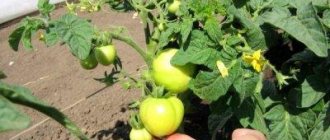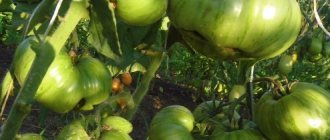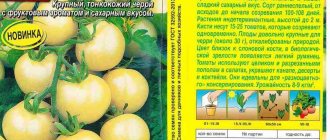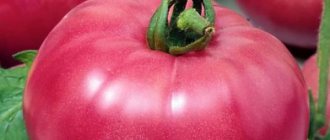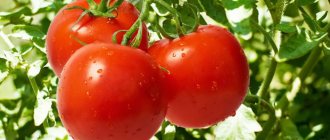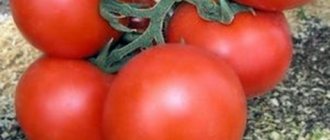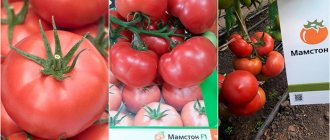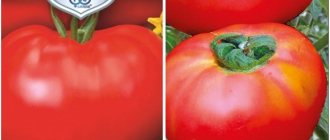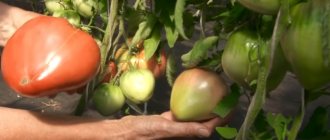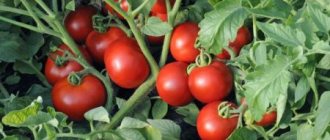Tomatoes: advantages and disadvantages
The main advantages of the tomato variety “Red Pearl” include:
- Versatility of cultivation: indoors and outdoors, as well as at home;
- Fast ripening time;
- Resistance to temperature changes;
- Good tolerance to lighting deficiency;
- Excellent taste characteristics of the fruit;
- Having high immunity to major diseases;
- Low maintenance requirements;
- Compactness of the plant.
Among the disadvantages of the variety are:
- Not the highest level of productivity;
- There is no possibility of long-term storage of the harvested crop.
Description of Pearl tomatoes
The Pearl tomato has more than 5 different types, each worthy of special attention.
Description of Pearl tomatoes
Characteristic
Pearl is a relatively new type of tomato. It is grown both in greenhouses and in open ground, the main thing is constant watering and fertilization. This type of tomatoes is classified as decorative. The plant loves sunny and warm places.
The bushes are small in size, 30-40 cm. The growth of the plant at the time of ripening depends on the size of the pot in which the tomatoes are kept. Pearl tomatoes come in the following types:
- pearls of Siberia;
- yellow pearl;
- red pearls;
- pink pearl.
Features of the view
Each type from this family has a number of differences:
- productivity;
- unpretentiousness;
- excellent taste;
- Red color;
- resistance to diseases;
- ease of cultivation.
Pearl of Siberia
The Pearl of Siberia is a new type of tomato bred in this region. It is famous for its high yield and excellent taste. It is grown using seeds and is not a hybrid type. The Pearl of Siberia has a strong and strong root system, which makes it possible to grow in any conditions and still produce a good harvest; the entire system develops in width.
The bush grows to almost 145 cm, the stem is strong and powerful, and has several clusters with fruits. The leaves of this plant are small in size, shaped like potatoes, and dark green.
The variety gives good yield: on average, more than 8 fruits are obtained from one gem. Ripening is average, the first fruits are obtained after 110 days. The description of tomatoes is simple: they are round, tasty, and easy to grow.
The ripening process is interesting: first the lower and then the upper fruits ripen. The plant has good immunity, which facilitates the growing process
Red Pearl
This variety is suitable for growing at home
The fruits have a decorative basis; they are grown both in gardens and at home on the windowsill. The red pearl grows small, maximum 34-45 cm. The fruits are small, somewhat reminiscent of cherry tomatoes. One fruit weighs 25-35 g. The total number of chambers reaches 2, the percentage of dry substances is not higher than 6%.
The downside is that such tomatoes do not last long after assembly, so it is impossible to transport the product over long distances.
The variety perfectly combines acid and sugar. More than 1.5 kg is collected from one bush, and from 4 bushes per 1 sq. m receive over 6 kg. According to the description, the advantages of the variety are:
- the ability to grow tomatoes at home;
- fast ripeness;
- adaptability to lack of lighting;
- ability to withstand sudden temperature changes;
- resistance to diseases;
- ease of care.
Yellow pearl
Yellow pearls are mini tomatoes. The fruits of this garden crop are yellow. The plant is unpretentious and easy to grow. The main thing is to water it on time and sometimes give additional vitamins and fertilizers. Yellow pearl is a determinate hybrid.
The fruits ripen quickly, from the moment of planting to the moment of harvesting, 84-94 days pass. The plant is low: maximum height - 61 cm, minimum - 35 cm. It all depends on which parents are chosen for it. Mature fruits are bright yellow in color, round and small in shape.
The weight of one fruit is 20-35 g. It is recommended to tie the bushes to lighten the load on the plant. Positive characteristics of the variety:
- good resistance to lack of light;
- ability to withstand sudden temperature changes without loss of yield;
- high percentage of resistance to diseases and pests.
Growing tomatoes at home
The “Red Pearl” tomato is traditionally cultivated through seedlings.
How to prepare seeds?
Description:
- Before sowing, the seeds must be disinfected and treated to prevent late blight infection. The disinfectant solution is a solution of potassium permanganate, in which the seeds are soaked for 20 minutes. Further. to increase germination and obtain strong plants, the seed material is treated in Epin or another growth stimulant for 10-12 hours;
- It is better to sow seeds in sprouted form. To do this, they are placed in a small saucer and covered with moistened gauze on top. The seeds are left in a warm place for 3-4 days until sprouts appear.
Sowing seed material
Description:
- It is optimal to sow seeds for seedlings 1.5-2 months before planting in a permanent place;
- Urea, wood ash, superphosphate and potassium fertilizer are added to the turf soil. Mix everything thoroughly until a homogeneous mass is used to fill the containers;
- Tomato seeds are laid out in shallow grooves (from 1 to 1.5 cm), maintaining an interval of approximately 2 cm;
- The soil is slightly moistened before sowing;
After sowing, the containers are covered with a film cover, which will keep the soil moist.
- Containers are placed in a dark and warm place (from +25 to +30 degrees) until sprouts appear. As the soil dries, spray it with warm water;
- After germination, the containers are moved to a lighted windowsill and the cover is removed. The required temperature during the daytime is +22...+25 degrees, at night - +15...+17 degrees;
- After the formation of a pair of full-fledged leaves, the seedlings are transplanted and planted in a permanent place.
Rules for planting seedlings
Description:
- When planning to grow in unprotected soil, planting dates must be determined taking into account weather conditions. At least 14 days must have passed since the last frost;
- It is advisable to grow in a sunny area;
- Recommended planting pattern: 40x60 cm.
Landing
Sowing begins in mid-March. To grow a house in a pot, seeds are planted all year round.
Prepare the soil by mixing turf soil with humus or compost, peat and fertilizers. Sand or sawdust is added for drainage. If the acidity of the mixture exceeds pH 6.5, add wood ash.
Dilute potassium permanganate until slightly pink, soak the seeds for half an hour. The solution is poured onto the soil. The turf is calcined in advance in the oven and allowed to cool. Disinfected seeds are rinsed and soaked in a stimulant solution for 30 minutes.
The grains are carefully placed in grooves 1–2 cm deep, moistened well, and covered with a layer of soil. Cover with glass and place it near the radiator so that the air temperature is +20–25 degrees. After 7–10 days, shoots will appear.
The containers with the sprouts are opened and moved to a sunny place. They need a temperature of +16 for the first three days to strengthen the roots and prevent stretching. At night the indicators increase to +18, and during the day - to +22.
Water the seedlings with a teaspoon; if necessary, add a weak solution of urea or ammophosphate 1-2 times. With the appearance of 1-2 true leaves, they dive.
They dive into disposable peat pots. If they are not available, cups are made from newspapers folded in several layers.
Pre-hardened bushes are planted on the garden bed at the age of 50–60 days. Plantings can be thickened.
Bush care
What care measures are needed:
- Water the tomato crop regularly. Watering is carried out directly under the bush, since moisture that gets on the foliage can provoke the occurrence of many diseases;
- Each watering procedure should be completed by loosening. Thanks to it, air exchange improves, which allows the root system to develop normally;
- The tomato does not need to form a bush;
- The variety responds well to the application of both organic fertilizers and mineral complexes;
- Bushes are hilled as necessary.
An important step is to install reliable supports; this will avoid possible breaking of branches with a large number of ripening fruits.
Characteristics
Tomato Zhemchuzhina Yellow is a cold-resistant variety. It tolerates sudden changes in temperature and humidity well. Does not stop development even during long periods of cold weather. Does not suffer from diseases associated with damp and cool weather.
The tomato variety Zhemchuzhina Yellow ripens within three months from germination and is an early ripening variety. The fruiting period is extended over time. It starts at the end of June and continues until mid-September. In greenhouses, plants most often produce fruits before the onset of persistent cold weather.
Interesting fact!
You can take advantage of the shade tolerance of the Zhemchuzhina Zheltaya variety and extend the growing season. In September, carefully dig up the bush and plant it in a flowerpot. It will bear fruit for about two more months.
The variety is one of the highest-yielding among cherry tomatoes, because the yield of the Yellow Pearl tomato is up to 6 kg/sq. m.
To increase productivity, it is very important to collect ripe fruits on time. One of the positive characteristics of the Yellow Pearl tomato causes harm to it. The fact is that the plant is not prone to shedding fruits and at the same time continues to actively form ovaries. A large number of ovaries and tomatoes of varying degrees of maturity leads to the inability of the root system to restore the balance of nutrients. At such moments, barren flowers appear on the bush, and the formed ovaries slow down development and maturation. The Zhemchuzhina Zheltaya variety has good commercial qualities. The fruits are not prone to cracking due to excess moisture, are stored for a long time without loss of taste and marketability, and tolerate transportation well.
Bright cherry tomatoes of the Zhemchuzhina Yellow variety are excellent for whole-fruit canning. They will look especially beautiful in jars next to red or dark cherries. During heat treatment, tomatoes do not crack and retain their taste and shape. Tomatoes are also consumed fresh.
"Pros and cons"
Reviews about growing Zhemchuzhina Zheltaya tomato are mostly positive. Vegetable growers note the following advantages of cherry tomatoes:
- high productivity;
- early ripeness and long fruiting period;
- cold resistance and shade tolerance;
- versatility in growing methods;
- attractive appearance and excellent taste;
- high commercial quality of tomatoes.
Diseases and pests
The tomato variety “Red Pearl” is practically not susceptible to fungal diseases, due to the presence of high immunity. Most often, diseases arise as a result of improper care or are associated with a lack of nutrients and microelements. To prevent diseases, it is necessary to use the right fertilizers, observe the lighting regime, and water correctly.
Frequent guests on tomato plantings are aphids and thrips. They control pests using commercial preparations, for example “Zubr”. You can also use folk remedies - use herbal decoctions.
Both methods are equally effective against pests and prevent repeated damage to the crop.
Red Pearl tomato: characteristics and description of the variety, yield, photo
Cherry lovers should pay attention to this tomato variety, Red Pearl. The tomato not only has an attractive appearance, but also allows the gardener to enjoy the wonderful taste of high-quality fruits.
Considering the characteristics of the Red Pearl variety, they note that the plant is easy to care for. You don't have to own a plot of land or build a greenhouse to try growing your own tomato crop. Red pearl can bear fruit well in garden pots, which means it can be planted indoors.
Description of the variety
This is an early ripening tomato, whose bushes are characterized as standard, hybrid, determinate. In order to collect the first ripe fruits, the farmer has to wait only 85 days minimum from the moment of sowing the tomatoes.
The plant is small, its maximum height is 40 cm. The versatility in terms of growing conditions of Black Pearl allows the variety to compete with the popular Balcony Miracle tomato. In addition, this crop has good defenses when it comes to diseases and temperature changes.
The hybrid plant is the fruit of the work of Ukrainian breeders, who in the early 2000s presented farmers with new compact fruits with a characteristic unique taste and external features similar to cherry tomatoes. The variety was registered in Russia a few years later. Almost immediately, the tomato gained the attention of many farmers. The popularity of Red Pearl in Russia is explained by the fact that the variety allows gardeners to get a large harvest.
At the stage of biological maturity, the fruits of the Red Pearl become red. Their color is rich and their shape is perfectly round. There are no ribs on the surface of the tomatoes, even at the stalk. Each fruit weighs from 20 to 40 grams. This is typical for many cherry tomatoes. Each tomato has a pair of seed chambers. The percentage of dry matter is 6%.
Professionals recommend consuming the red pearl variety fresh or using it to create vitamin-rich salads. This variety of tomato is unsuitable for growing for commercial purposes due to the low shelf life of the fruit. In addition, you should not hope for the safety of the crop after long-term transportation. The skin of the fruit is not dense enough to protect the pulp from mechanical damage.
Despite the fact that Red Pearl tomatoes do not tolerate transportation well, they cope with heat treatment with a bang. This means that the fruits can be used for preservation. Many farmers love to grow crops for processing. The ideal balance of sugar content allows you to create delicious, healthy juices and purees from such tomatoes.
In terms of yield, the gardener has nothing to worry about. Proper care will allow the farmer to collect 2-4 kg of fruit from each plant. But the main condition remains proper care and suitable planting density - no more than four bushes per square meter. Farmers who use additional methods to increase productivity achieve a result of 6 kg of fruits per bush. This is a good result for a cherry tomato. If we consider the compactness of the plant, then the indicator can safely be called high.
Landing rules
You need to plan sowing for seedlings 45-50 days before transplantation. It is important for farmers to take into account weather conditions if cultivation is planned in open ground. More than two weeks must have passed since the last frost.
To be on the safe side, it is advisable to sow a little more tomatoes than the gardener actually intends to grow. This allows you to choose the strongest bushes when replanting and protect yourself. If some young plants have been damaged.
During the seedling period, the sprouts are provided with a stable temperature, not lower than 18 degrees Celsius, but not higher than 27 degrees. Any fluctuations outside the designated limits may affect the further growth and health of tomatoes.
You should refuse feeding at this time. It is better to provide for the use of high-quality soil mixed with fertilizers and additives for better drainage ability of the soil mix.
Watering should be moderate so that the top layer of soil in the pot remains moist. The amount of light is also important. Plants should be exposed to light for at least 6 hours per day. If the lighting is artificial, then the lamps should be left to work for at least 8-10 hours.
Before transplanting, the bed is carefully processed and dug up. Fertilizer must be applied. If necessary, you can plant Red Pearl tomatoes using the deep planting method with the removal of a couple of permanent leaves of the seedlings. But this method of strengthening the plant should only be used by experienced farmers.
- Growing Red Pearl tomatoes does not require a lot of effort and energy. A big plus for many will be the absence of the need to form several stems.
- Irrigation should be, as in the case of other types of heat-loving crops, regular. It is necessary to water tomatoes under the bush. Irrigation from above carries the risk of developing a number of diseases.
- After each watering, it is advisable to loosen to maximize air exchange and promote normal development of the root system. It is known that the wider the root system of tomatoes, the greater the chance that the plant will be resilient during periods of weather unfavorable for growth.
- In terms of fertilizer, Red Pearl is unpretentious. It responds equally well to both organic and mineral fertilizers. If necessary, hilling is carried out.
Diseases and pests
Red Pearl rarely suffers from fungal diseases. Fortunately for many farmers, the crop has high immunity to these diseases. Many problems that can develop in a variety are more often associated with improper care regimens or deficiencies of nutrients and microelements. Using the right feeding materials, suitable lighting, and proper watering can prevent many diseases.
Productivity
Taking into account the creation of optimal conditions and proper care, the “Red Pearl” tomato guarantees up to 1.5 kg of yield from each bush. From 1 m2 (when planting no more than 4 seedlings) you can get about 6 kg of tomatoes. Considering the compactness of the plant, this is a pretty good result.
Which regions are best to grow in?
Good tolerance to temperature fluctuations allows it to be grown in open ground not only in the south, but also in the middle zone. In regions with cold climates, heated greenhouse structures are used for cultivation.
Description of the tomato variety Yellow Pearl and cultivation features
Gardeners grow various wonders on their plots. The Yellow Pearl tomato is ideal for a balcony garden. A neat bush actively bears fruit in a flower pot. Sweet amber berries are pleasing to the eye and pleasant to the taste.
How is it different from other cherry tomatoes?
Cherry tomatoes have long been popular. Gardeners grow small tomatoes to create exquisite culinary compositions, decorate dishes, and whole-fruit canning.
Breeders have developed a fundamentally new line: tomatoes for growing on the balcony. Anyone who has the desire and a small, bright window sill could become a summer resident. In open ground, yellow pearl tomato should be compacted into the main plantings.
- early ripening (from germination to ripening What ripens on the bushes
The Yellow Pearl bush is quite decorative. When the fruit is pouring, it is strewn with bright beads.
- mass Breeders' advice
Balcony tomatoes grow in unusual conditions. To obtain a decent amount of fruit, you must follow the growing rules:
- Seedlings should be started in the second ten days of March;
- in the phase of two leaves, pick up, deepen to the cotyledons;
- choose the size of the pot for further growth;
- harden the plant, feed it;
- avoid sunburn (shade in bright light);
- It is recommended to combine watering with fertilizing;
- the plant overloads itself with fruits: supports are required;
- the soil should be loosened regularly;
- contribute N:P:K;
- ventilate the plant;
- remove ripe tomatoes.
The plant lives at low air humidity. Spider mites live in these same conditions. The Yellow Pearl should be inspected regularly. If damage is detected on the back side of the leaves, it is necessary to spray the bush with insecticides.
Why gardeners like Pearl
This unpretentious variety is loved by summer residents. It is grown on city balconies, planted with tall tomatoes, and placed on verandas. The reviews are good. Gardeners love unpretentious tomatoes. People appreciated the yield, transportability, universal purpose of the fruit, and pleasant taste.
Summer residents note: the variety is responsive to mistakes during cultivation. Violation of the rules of agricultural technology reduces yields. Sometimes, with poor care, a tomato dies.
Reviews about the variety from those who planted
The variety is popular among urban residents. The miniature size of the plant allows you to grow the “Red Pearl” tomato at home. And this is an opportunity to receive vitamin-rich fresh tomatoes all year round.
Indoor tomatoes:
The tomato variety “Red Pearl” can be considered ideal: in the summer, the crop can be harvested from the beds, and with the onset of winter, grown on the balcony. Also, thanks to its decorative properties, a tomato can become an element of decor for a balcony, room, winter garden, or patio.
